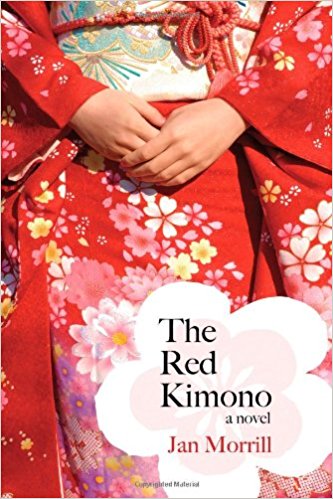The Red Kimono (book)
Creators: Jan Morrill
Novel that tells parallel stories of a Japanese American family that is uprooted from their Berkeley, California, home and sent to American concentration camps during World War II, and a young African American man who goes to prison for the beating death of that family's patriarch.
Synopsis
As the story begins, the Kimuras—father Michio, mother Sumiko, Nobu, a senior at Berkeley High School, and Sachi, a 4th grader—live an idyllic life in Berkeley, where Michio works at a Japanese bank. Older brother Taro is in Hawai'i, where he works on a sugar plantation . But the attack on Pearl Harbor brings increased prejudice and tensions, and two weeks later, three boys from the high school beat up Michio, sending him to hospital in a coma. One of them is Nobu's African American friend and basketball teammate, Terrence Harris, whose father had been killed at Pearl Harbor. Despite his injuries, Michio is arrested by the FBI and taken away; while in their custody, the family receives word of his death. We follow the Kimuras as they are uprooted and taken to the Santa Anita Assembly Center , then to the Rohwer , Arkansas, concentration camp. Meanwhile, Terrence pleads guilty to manslaughter and receives a two-year sentence.
The 71 short chapters are told from the perspectives of Sachi (32 chapters), Nobu (21), and Terrence (18). Sachi—who grows into a young women while in camp—often finds herself at odds with her mother, particularly when she befriends a boy from an outcast family at Santa Anita, and Jubie, an African American girl at Rohwer. Nobu struggles to control his anger at his family's treatment, and, in protest, answers " no-no " to the loyalty questions , and ends up at Tule Lake . Terrence struggles to come to terms with his crime; with the support of his family and his lawyer, he befriend his initially racist white cellmate and begins to study for college with the hope of contributing to a better society.
Background and Historical Accuracy
Author Jan Morrill (1958– ) was born in California to a Japanese American mother and white American father, the eldest of five children. Her mother, Miyoko Sasaki, was around the same age as Sachi when she and her family were incarcerated at the Tule Lake and Topaz camps. Her mother's father had also been killed by an African American teenager. Morrill began the book as a biography of her mother, but found it difficult to go that route since her mother and many of her siblings were still alive. Her mother did eventually read the manuscript and suggested some changes in it. Morrill is working on a sequel to The Red Kimono that follows Sachi, Nobu, Jubie, and Terrence from 1957 to 1963. [1]
Though the portrayals of life in the concentration camps conforms to inmate accounts, there are several instances of both chronology and camp assignment issues. Regarding chronology: Michio dies enroute to the Santa Fe internment camp on around January 1, 1943 (page 57); however Santa Fe didn't open for another month. The Kimuras spot the exclusion order poster on April 1 and are picked on Van Ness Street on April 7 (66–67, 80); while these are the dates and the location for parts of San Francisco, Japanese Americans in Berkeley were rounded up a month later, on May 1. Nobu observes both people arriving at Santa Anita and being taken from Santa Anita to WRA camps on June 19 (113); all inmates at Santa Anita had arrived by the end of May and the first shipments from Santa Anita to WRA camps didn't take place until the end of August. Nobu gets transfer orders to go to Tule Lake in March and is sent there shortly thereafter (237); segregation didn't begin until later that fall. Regarding camp assignments: As Berkeley residents, the Kimuras would have been sent to Tanforan ; however their bus is mysteriously diverted to Santa Anita at the last minute, a site nearly 400 miles away. Nobu's Tule Lake roommate Ichiro is from Sacramento, but is sent to Tanforan and Topaz (256); Sacramento Japanese Americans typically went to the Sacramento or Pinedale Assembly Centers and then to Tule Lake or Poston .
Might also like: The Little Exile by Jeanette S. Arakawa; When the Emperor Was Divine by Julie Otsuka; Garden of Stones by Sophie Littlefield
Foototes
- ↑ The Red Kimono blog, https://theredkimono.wordpress.com/ and "Q&A with Jan Morrill," Book Q&A with Deborah Kalb, Feb. 11, 2015, http://deborahkalbbooks.blogspot.com/2015/02/q-with-jan-morrill.html , both accessed on July 24, 2017.
| Author | Jan Morrill |
|---|---|
| Pages | 307 |
| Publication Date | 2013 |
For More Information
Author website, http://www.janmorrill.com/ .
The Red Kimono blog: https://theredkimono.wordpress.com/ .
Publisher website, http://www.uapress.com/titles/sp13/morrill.html .
Reviews
Asakawa, Gil. Nikkei View , April 30, 2013. ["The book is an intriguing study of racial enmity and the need for forgiveness. By the unexpected conclusion, readers will feel as if the characters are part of their own family."]
Publishers Weekly , Feb. 11, 2013. ["It reads like a story better suited for a visual medium, where prolific ideas are not as easily outweighed by poor language."]
